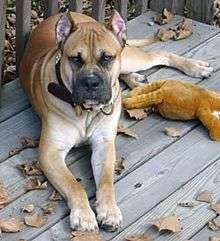Bullenbeisser
 | |
| Country of origin | Germany |
|---|---|
| Dog (Canis lupus familiaris) | |
The Bullenbeisser (also known as the German Bulldog) was a breed of dog known for its strength and agility. The breed was closely related to the Bärenbeisser (some believe that the two breeds were the same; the names mean "bull-biter" and "bear-biter," respectively), and the Boxer. It was in all its aspects similar to the present Alano Español and very alike to the Dogo Argentino, not only in aspect, but also in usage. There were two regional varieties, the Brabanter Bullenbeisser and the Danziger Bullenbeisser. The breed is now extinct.[1][2]
Extinction
The Bullenbeisser became extinct by crossbreeding rather than by a decadence of the breed, as happened with the Old Time Bulldog, for instance. The size of the Bull Biters varied from about 40 to 70 cm by 1850; the smaller lived from what today is Netherlands and Belgium, and the bigger, in Germany. In the late 1870s, German breeders Roberth, Konig, and Hopner used the dog to create a new breed, today called the Boxer. Some 30 Bullenbeissers were already crossed by the Boxer Kennel Club of Germany at 1900 in with Bulldogs brought from the British Isles. The blood composition was 50/50 at that time, however, the German owners started crossing their dogs with all kinds of Bulldogs and Boxers, which produced an undistinguishable breed after World War II. One reason why such quantity of German blood was used to create the Boxer dog was the wish to eliminate the excessive white colour of the breed, and the necessity of producing thousands of dogs for one of the most popular breeds in the world.
Present-day "Bullenbeisser Generation"
Bullenbeisser generation is a name for those still existing dog breeds, which have been developed partly out of the Bullenbeisser breed. Although they have some Bulldog genes, their appearance and use are more similar to the original Bullenbeisser. These breeds - with the exception of the rare Spanish Bulldog, which almost became extinct in the 1980s - started to gain great popularity.
The proportions of the Bullenbeisser bloodlines vary much between the different breeds. While 70 % of the Boxer's genetic heridence comes from the Bullenbeisser (and 30 % from the Bulldog), the American Pit Bull Terrier is the only purely direct descendant of the Bullenbeisser. Originally, the base for the Great Dane breed was 50 % Bullenbeisser and 50 % English Mastiff and Irish Wolfhound blood. However, later there were still additions of the Dalmatian and German Pointer.
Judging by the appearance and over-all breed type, the closest present-day descendants are the Argentine Dogo (as well as the two other Latin American Dogo breeds) and Spanish Bulldog. The original Cordoba Fighting Dog - the progenitor of the Argentine Dogo - was a cross between the Boxer, Bull Terrier, Bulldog and a some kind of mastiff, while the Guatemalan Dogo is based on a mixture between the Boxer, Bull Terrier and Dalmatian. Another Bullenbeisser-based breed, the Boerboel descends from a cross-breeding between the Bullenbeisser, Bullmastiff and Great Dane.
Typical characteristics of Bullenbeisser descendants include:
- Upper lips partially fall over the jaws
- Underbite
- Wide and strong jaws with a great bite force
- Large muscles
- Great agility and strength
- Molosser type
- Medium size (except the Great Dane)
- Good guardian and family companion
- Genetic tendency (except the Boerboel)
See also
References
- ↑ Royal Canin. "Canine Health Nutrition - MAXI Dog Origin (Boxer)". Retrieved 2007-08-04.
- ↑ SarahsDogs.com. "Sarah's Dogs: Breeds: Boxer". Retrieved 2007-08-04.
External links
| ||||||||||||






